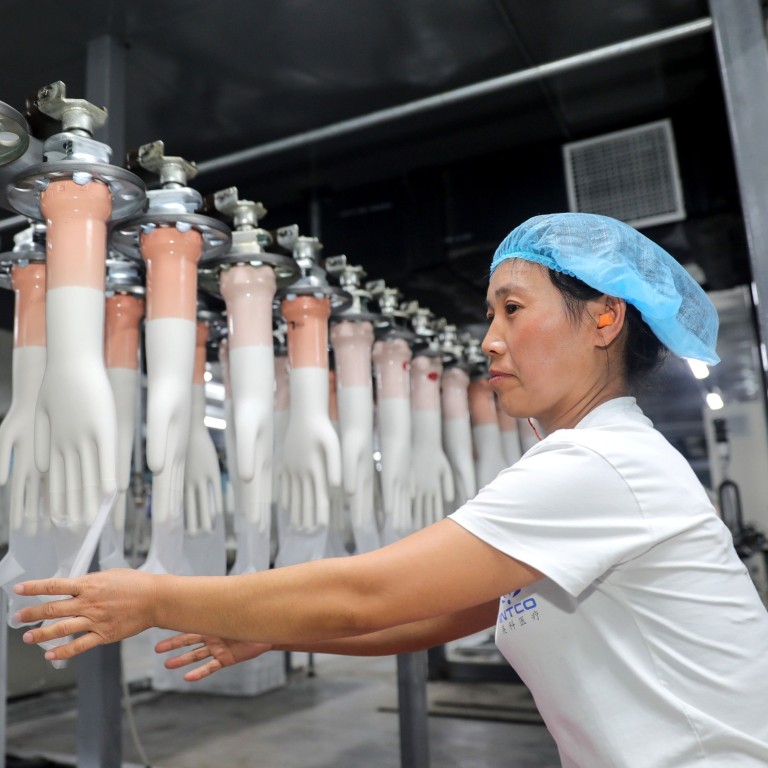
China’s manufacturing remained weak in September as activity contracted for fifth straight month, data shows
- The manufacturing purchasing managers’ index (PMI), released by the National Bureau of Statistics (NBS) on Monday, was 49.8
- Non-manufacturing PMI came in at 53.7, below analysts’ expectations of a 53.9 reading. The figure was also down from August’s 53.8
China’s manufacturing sector remained in the doldrums in September, with sentiment among factory operators remaining in negative territory for the fifth month in a row.
The official PMI is a gauge of sentiment among larger and state-owned factory operators, with 50 being the line between expansion and contraction in sector activity. In the survey, manufacturers are asked to give a view on business issues such as export orders, purchasing, production and logistics.
“Although the PMI reading is still in negative territory, the overall economy has improved,” said Zhao Qinghe, a statistician with the China Federation of Logistics and Purchasing, which produces the index with the NBS.
Zhao pointed to the “double expansion” of new orders and increased productivity for the slight improvement in September. The PMI indicated a 0.8 per cent increase in new orders, the largest expansion since May, while production also picked up by 0.4 per cent in sectors such as agricultural food processing, textiles, and electrical machinery.
Construction activities and housing construction dropped by 3.6 basis points and 4.1 basis points respectively compared to last month, but in terms of market demand, the new orders index rose to 55.1, up 1.2 percentage points compared to last month.
“This indicates that the market demand growth is stable. Hence, the construction industry is expected to continue to expand in the future,” added Zhao.
In an analysis by Martin Lynge Rasmussen, China economist from Capital Economics, the drop in the construction component overshadowed a pick-up in manufacturing-related services.
Despite the strong data we remain downbeat on the outlook. Not only is global demand set to weaken further, but the long-overdue pull-back in property construction is getting under way
“Despite the strong data we remain downbeat on the outlook,” he said. “Not only is global demand set to weaken further, but the long-overdue pull-back in property construction is getting under way. And with the fiscal stance is unlikely to be loosened during the remainder of the year, we think the [People’s Bank of China] will find it an increasingly hard sell to refrain from more decisive monetary easing.”
Also released by the NBS on Monday, non-manufacturing PMI came in at 53.7, below analysts’ expectations of a 53.9 reading. The figure was also down from August’s 53.8. This is a gauge of sentiment in the construction and services sectors.
The recovery in China’s manufacturing industry in September benefited mainly from the potential growth of domestic demand
“The recovery in China’s manufacturing industry in September benefited mainly from the potential growth of domestic demand. The trade conflicts between China and the US had a notable impact on exports, production costs and confidence of enterprises,” said Dr Zhengsheng Zhong, director of macroeconomic analysis at CEBM Group.
“Compared with growth in new orders, the employment situation recovered only a bit, indicating that structural issues may exist in the labor market. Central policymakers have recently been emphasising the strong growth in the domestic market. Faster construction of infrastructure projects, better implementation of upgrading the industrial sector, and tax and fee cuts are likely to offset the influence of the subdued overseas demand and soften the downward pressure on China’s economic growth.”
While there was a slight uptick on August’s official reading, the fact that manufacturing PMI remains in negative territory is indicative of the weak sentiment among producers, in a month when the trade war with the US escalated significantly. On September 1, new tariffs of 15 per cent on more than US$125 billion of Chinese goods went into effect.
With a tariff increase on US$250 billion of Chinese goods set to happen on October 15, prospects for the month ahead remain gloomy. Talks will resume in Washington on October 10 as US and Chinese negotiators look to find a deal to end the 15-month trade war, but at this point, the best most analysts dare to hope for is a ceasefire or postponement in October’s tariffs.


